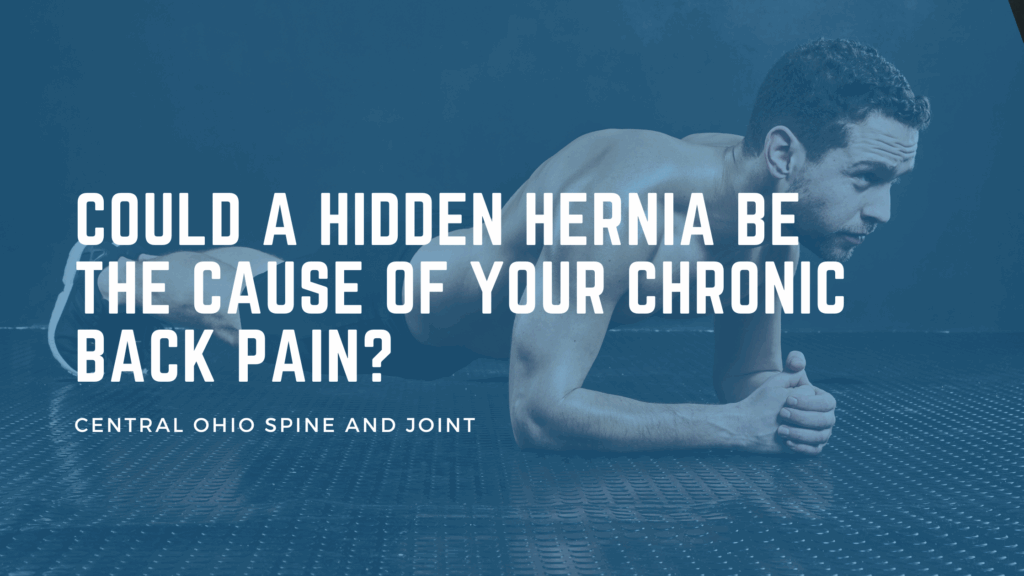How Hernias Can Cause Chronic Back Pain
When most people think about hernias, they think of a bulge in the abdomen or groin area. It’s true that a hernia is a protrusion of tissue through a weakened area of the abdominal wall, but what many people don’t realize is how deeply this can affect spinal mechanics—and ultimately, how it can lead to chronic low back pain.
Let’s break down how this connection works.
The Core as a Stability System
Your “core” isn’t just about abs—it’s a pressure management system designed to create stability for your entire trunk. Think of your core like a soda can. When the can is sealed and pressurized, it’s incredibly strong. But once the integrity of that can is compromised, it crumples easily under pressure.
Hernias represent a breach in this pressurized system. Whether it’s an inguinal hernia, umbilical hernia, or even a small diastasis recti (abdominal separation), these “leaks” create a loss of internal pressure and stability. Without that foundational support, your body has to find another way to maintain upright posture and prevent injury during movement.
That “Plan B”? Bracing the lumbar spine.
Compensation Through Spinal Stiffness
When the abdominal wall can’t provide stability, the deep muscles of the low back (like the multifidus and erector spinae) often kick in to pick up the slack. This creates a strategy of protective stiffness—which might help you stay upright, but comes at a cost.
Over time, this chronic bracing can result in:
- Constant muscle tightness in the low back
- Decreased spinal mobility
- Persistent, aching pain that worsens with movement or fatigue
- Increased risk of disc irritation or facet joint compression
In short, the spine becomes the scapegoat. It’s doing extra work, not because it’s inherently unstable, but because the core has a stability leak due to the hernia.

The Missing Diagnosis
Unfortunately, this underlying cause is often missed in traditional musculoskeletal exams. Providers may focus solely on joint mobility, spinal alignment, or muscle tension—without stepping back to ask why those patterns are present.
At our clinic, we take a broader view. If a patient has chronic low back pain that hasn’t responded to conventional treatment—adjustments, soft tissue work, or core stabilization—our next question is: Is there a reason the core isn’t stabilizing effectively?
This often leads us to:
- Abdominal wall palpation
- Diastasis recti assessments
- Functional movement screens that evaluate intra-abdominal pressure
Sometimes, imaging or surgical consults are necessary to confirm a hernia, especially if symptoms include abdominal bulging, groin pain, or strain with lifting.
Real-Life Example
Let’s say we have a patient with chronic low back pain that’s worse with standing, walking, or transitional movements like getting out of a chair. They’ve done rehab exercises and seen some improvement, but they always plateau.
Now imagine this patient has an undiagnosed inguinal hernia—just enough to impair abdominal pressure, but not enough to cause acute pain. Without realizing it, their nervous system has adapted by locking down the low back and overusing hip flexors to compensate. The result? A low-grade, persistent backache that never really goes away.
Repair → Retrain → Reinforce
At Central Ohio Spine and Joint, our approach always comes back to our 3-step system:
- Repair the Dysfunction:
If a hernia is diagnosed, we coordinate care with medical professionals for surgical consults when appropriate. But not all hernias require surgery. Some cases benefit from supportive bracing, activity modification, or manual therapy to reduce pressure and tension. - Retrain Core Mechanics:
Once the acute phase is addressed, we focus on restoring proper pressure management using exercises that activate the diaphragm, pelvic floor, and transverse abdominis. Think: breath work, DNS (Dynamic Neuromuscular Stabilization), and low-load, high-control movements. - Reinforce Functional Strength:
Finally, we layer in compound lifts, anti-rotation exercises, and movement patterns that help re-integrate a stable core with daily activities. The result? The spine no longer needs to brace unnecessarily, and chronic low back tension begins to fade.
What You Can Do
If you’ve been dealing with chronic back pain that doesn’t seem to respond to traditional treatments, consider the following:
- Check your core stability. Can you generate tension in your lower abs? Do you notice bulging or strain in your belly during exercises?
- Pay attention to pressure. Do you feel like your low back is doing all the work during tasks like lifting, reaching, or standing?
- Look for asymmetries. A hernia may present as a small bulge on one side of your groin or belly, especially when coughing or bearing down.
- Get assessed. Our team can evaluate you for signs of poor core function and rule out whether a hernia may be contributing to your pain.
Final Thoughts
Chronic low back pain is rarely caused by just one issue. But if you feel like you’ve tried everything—stretching, strengthening, chiropractic care, even injections—it’s time to zoom out and consider the big picture.
A hernia creates a hidden instability that shifts the load to your spine. Until you address that leak in the system, your back will keep trying to “lock down” in protection—and that cycle of pain will continue.
At Central Ohio Spine and Joint, we specialize in figuring out what’s really going on, and then guiding you through a plan that actually addresses the root cause.
If you’re struggling with chronic low back pain and nothing seems to work, schedule a consultation with our team. We’ll evaluate your core, screen for hernias, and build a treatment plan tailored to your body’s needs.
→ Schedule Your Discovery Call Today

Recent Comments